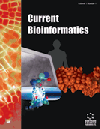- Home
- A-Z Publications
- Current Bioinformatics
- Previous Issues
- Volume 7, Issue 1, 2012
Current Bioinformatics - Volume 7, Issue 1, 2012
Volume 7, Issue 1, 2012
-
-
Editorial
More LessWhat can be compared to travel thousands of miles from your place, arriving for the first time in a new country and suddenly finding you at home? This is the experience the great writer and philosopher Gilbert Keith Chesterton described one hundred years ago equating his spiritual and intellectual experience to an English explorer that arrives, after a long and dangerous journey, to an island and suddenly discovers it is G Read More
-
-
-
Recent Directions in Compressing Next Generation Sequencing Data
More LessAuthors: Malay Bhattacharyya, Manas Bhattacharyya and Sanghamitra BandyopadhyayBioinformatics research in the last three decades has contributed quite a large number of methodologies for compressing genomic sequence data. However, recent progress in the next generation sequencing (NGS) techniques requires the development of more effective compression methods. In this review paper, a comprehensive overview of the state-of-the-art DNA sequence compression techniques for handling the exponen Read More
-
-
-
Generalized String Pseudo-Folding Lattices in Bioinformatics: State-of-Art Review, New Model for Enzyme Sub-Classes, and Study of ESTs on Trichinella spiralis
More LessSeveral graph representations have been introduced for different data in theoretical biology. For instance, Complex Networks based on Graph theory are used to represent the structure and/or dynamics of different large biological systems such as protein-protein interaction networks. In addition, Randic, Liao, Nandy, Basak, and many others developed some special types of graph-based representations. This special type Read More
-
-
-
Substitution Transformation of Score Matrix for Improving Alignment Quality of Local Sequence of Distantly Related Proteins
More LessAuthors: Juan Li and Huisheng FangThis paper presents a transformation method of original score matrix by correspondently normalizing its elements in row and column. The sequence alignment of 4830 superfamilies and 9570 fold related protein pairs showed that the quality of the alignment based on the transformed matrices is significantly improved compared to that based on the original matrices, especially for the fold related protein pairs, which is Read More
-
-
-
Biclustering Analysis for Pattern Discovery: Current Techniques, Comparative Studies and Applications
More LessAuthors: Hongya Zhao, Alan Wee-Chung Liew, Doris Z. Wang and Hong YanBiclustering analysis is a useful methodology to discover the local coherent patterns hidden in a data matrix. Unlike the traditional clustering procedure, which searches for groups of coherent patterns using the entire feature set, biclustering performs simultaneous pattern classification in both row and column directions in a data matrix. The technique has found useful applications in many fields but notably in bioinformatic Read More
-
-
-
Optimal Control for Generalized Asynchronous Probabilistic Boolean Networks†
More LessAuthors: Qiuli Liu, Xianping Guo and Tianshou ZhouAs a paradigm for modeling gene regulatory networks, synchronous or asynchronous probabilistic Boolean networks (PBNs) provide us an effective tool to design therapeutic intervention strategies. However, most of the previous works focused on the former and only few studied the latter. This paper deals with an optimal control problem in a generalized asynchronous PBN by applying the theory on semi-Markov decision proces Read More
-
-
-
Comparative Analysis of Clustering and Biclustering Algorithms for Grouping of Genes: Co-Function and Co-Regulation
More LessAuthors: Anindya Bhattacharya, Nirmalya Chowdhury and Rajat K. DeIn this article, we discuss the basic challenges of clustering on gene expression data. In particular, we divide the methods of clustering into eight different categories. Then, we present specific characteristics pertinent to each clustering category. We compare the results of 27 clustering/biclustering algorithms on various gene expression datasets using different cluster validation indices. Comparison is made in t Read More
-
-
-
13C Metabolic Flux Analysis: From the Principle to Recent Applications
More LessAuthors: Luciana Calheiros Gomes and Manuel SimoesMetabolic flux analysis (MFA) has become a fundamental tool for quantifying metabolic pathways, which is essential for in-depth understanding of biological systems. In experimentally based MFA, isotopically labeled substrates are supplied to a biological system and the resulting labeling patterns are analyzed to obtain internal flux information. Three main techniques are necessary for 13C MFA: (i) a steady state cell cultur Read More
-
-
-
Protein Aggregation in Neurodegenerative Diseases: Insights from Computational Analyses
More LessAuthors: Anita Sarkar, Sonu Kumar, Abhinav Grover and Durai SundarBiological aggregation is a process where bio-macromolecules such as proteins, lipids and nucleic acids essentially self-associate in an ordered fashion into functional complexes (that may be normal or pathological) and finally precipitate out due to formation of higher order conglomerates of low solubility. Neurodegenerative diseases are, in general, associated with the deposition of pathogenic aggregates composed of amy Read More
-
-
-
Bioinformatics Tools for Mass Spectroscopy-Based Metabolomic Data Processing and Analysis
More LessAuthors: Masahiro Sugimoto, Masato Kawakami, Martin Robert, Tomoyoshi Soga and Masaru TomitaBiological systems are increasingly being studied in a holistic manner, using omics approaches, to provide quantitative and qualitative descriptions of the diverse collection of cellular components. Among the omics approaches, metabolomics, which deals with the quantitative global profiling of small molecules or metabolites, is being used extensively to explore the dynamic response of living systems, such as organelles, cells, tis Read More
-
Volumes & issues
-
Volume 20 (2025)
-
Volume 19 (2024)
-
Volume 18 (2023)
-
Volume 17 (2022)
-
Volume 16 (2021)
-
Volume 15 (2020)
-
Volume 14 (2019)
-
Volume 13 (2018)
-
Volume 12 (2017)
-
Volume 11 (2016)
-
Volume 10 (2015)
-
Volume 9 (2014)
-
Volume 8 (2013)
-
Volume 7 (2012)
-
Volume 6 (2011)
-
Volume 5 (2010)
-
Volume 4 (2009)
-
Volume 3 (2008)
-
Volume 2 (2007)
-
Volume 1 (2006)
Most Read This Month
Article
content/journals/cbio
Journal
10
5
false
en


